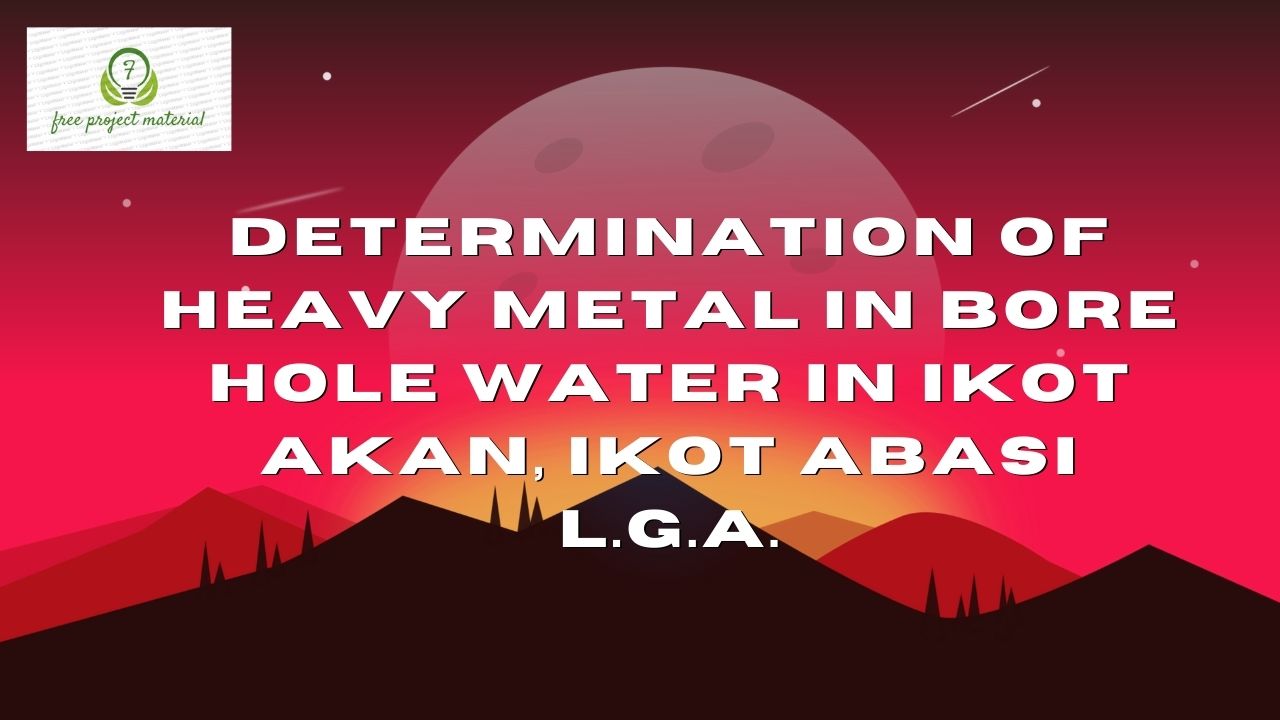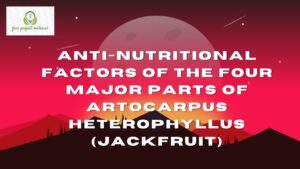ABSTRACT
The determination of heavy metal in bore hole water from Ikot Akan, Ikot Abasi: Local Government Area, Akwa Ibom State shows that borehole water contain lead (Pb), chromium (Cr), Arsenic (As) and Mercury (Hg), with the following concentrations: 0.0020±0.0000 mg/kg, 0.0955±0.0000 mg/kg, 0.0345±0.0003 mg/kg, 0.1155±0.0000, mg/kg and 0.0010±0.0000 mg/kg respectively. From the result, lead and mercury are below the WHO permissible standard while chromium, cadmium and arsenic are above the recommended level. Therefore, standard measures such as water treatment, proper hygiene should be taken to normalize the level of heavy metal in Ikot Akan borehole water, to avoid health issues due to high level of heavy metal contaminant in the water. This research work will serves as first-hand information to the Ikot Akan community, borehole owner and consumers of borehole water.
TABLE OF CONTENTS
Title Page – – – – – – – – – i
Certification – – – – – – – – – ii
Dedication – – – – – – – – – iii
Acknowledgements – – – – – – – iv
Abstract – – – – – – – – – v
Table of Contents – – – – – – – – vi-vii
CHAPTER ONE: INTRODUCTION
1.1 Background of the Study – – – – – – 1-7
1.2 Aim and Objectives of the Study – – – – 8
1.3 Scope and Limitation of the Study – – – – 8
CHAPTER TWO: LITERATURE REVIEW
2.1 Heavy Metals and the Eco- and Biosphere – – – 9-12
2.2.1 Cadmium – – – – – – – – 12-18
2.2.2 Mercury – – – – – – – – 19-23
2.2.3 Lead – – – – – – – – – 24-28
2.3 Mitigating Heavy Metals – – – – – – 29-34
2.4 Borehole Water Quality – – – – – – 34
2.5 Sources of Domestic Boreholes Pollution – – – 35-36
2.6 Treatment Methods and Equipment – – – – 36-40
2.7 Maintenance of Treatment System – – – – 41-42
CHAPTER THREE: MATERIALS/METHOD
3.1 Materials – – – – – – – – 43
3.2 Method – – – – – – – – – 43
3.2.1 Sample collation and preparation – – – – 43
3.2.2 Digestion – – – – – – – – 44
3.2.3 Analysis of heavy metal content – – – – – 44
CHAPTER FOUR: RESULT AND DISCUSSION
4.1 Results – – – – – – – – 45
4.2 Discussion – – – – – – – – 46-48
CHAPTER FIVE: CONCLUSION AND RECOMMENDATION
5.1 Conclusion – – – – – – – – 49
5.2 Recommendation – – – – – – – 49
References
CHAPTER ONE: INTRODUCTION
1.1 Background of the Study
The activities of man have resulted in the contamination and pollution of nature. As a result of these continuous activities man’s natural environment such as soil (land), water and air have been greatly degraded. The continuous neglect and improper implementation of programmes to mitigate these activities may have resultant effect on the life of man and other organisms that occupy the face of the earth (Adesomoye et al., 2006; Edori and Kpee, 2016). For life to effectively function, water plays an important role. The ability of man to access portable water for drinking is purely based on its availability. The wellness of life, be it man or other living creatures, depends on the availability of water for drinking and other purposes (Halilu etal, 2011). The proper use of water resources and its reach to man is a worldwide challenge, most especially in the continents of Africa and Asia (WHO, 2004).
Water is an essential resource for living systems, industrial processes, agricultural production and domestic use. Ninety seven percent of the world’s water is found in oceans. Only 2.5% of the world’s water is non-saline fresh water (Itodo and Itodo, 2010). However, 75% of all fresh water is bound up in glaciers and ice caps. Only 1% of fresh water is found in lakes, rivers soils and 24% is present as ground water. The use of water increases with growing population, putting increasing strain on these water resources. An adequate supply of safe drinking water is one of the major prerequisites for a healthy life. The importance of clean water and the link between contaminated or putrid water and illness was recognized in the distant past, even though the actual cause of disease was not properly understood until the latter half of the 19th century (WHO, 2000).
Finding adequate supplies of fresh to meet the ever increasing needs, and maintaining its quality, is becoming a problem. Although water availability is not a problem on a global scale, it may be a problem finding high quality fresh water at the required place, in the required quantity (Radojavic and Vladimir, 2004). As a result of the increasing demand for water and shortage of supply, it is necessary to increase the rate of water development in the world and to ensure that the water is used more efficiently. Drinking water should be suitable for human, consumption and for all usual domestic purposes (WHO, 2005). The importance of water in daily living makes it imperative that thorough examinations be conducted on it before consumption. A drinking water quality guideline value represents the concentrations of a constituent that those not result in any significant health risk to the consumer over a lifetime. The amount by which and for how long, any guideline value can be exceeded without endangering human health depends on the specific substance involve (AWA, 2009).
Heavy metals in water refers to the heavy, dense, metallic elements that occur in trace levels, but are very toxic and tend to accumulate, hence are commonly referred to as trace metals. The major anthropogenic sources of heavy metals are industrial wastes from mining sites, manufacturing and metal finishing plants, domestic waste water and run off from roads. Many of these trace metals are highly toxic to humans, such as Hg, Pb, Cd, Ni, As, and Sn. Their presence in surface and underground water at above background concentrations is undesirable (Radojavic and Vladiir, 2000). Some heavy metals such as Hg, Pb, As, Cd, Fe, Co, Mn, Cr e.t.c have been identified as deleterious to aquatic ecosystem and human health (Bhatia, 2001). Fatoki et al., (2002) investigated trace metal pollution in the Umtata river and reported high levels of Al, Cd, Pb, Zn, and Cu, which may affect the “health” of the aquatic ecosystem. Also, Raphael et al. (2009) investigated heavy metals concentrations from three streams in eggom hills in Nasarawa state and reported high levels of Mn, Ni, Fe, Co, Cr, Cd and Pb, which may affect the health of the community. This present study is therefore aimed at investigating the level of some metals in selected bore-hole within Ikot Abasi Local Government Area, Akwa Ibom State.
In addition, to a small extent, the metals enter the human bodies via food, drinking water and air. Though, some heavy metals (e.g. copper, selenium, zinc) are essential to maintain the metabolism of the human body, but, concentrations above the desirable level can lead to poisoning (Lenntech, 2011). Heavy metal poisoning could result, for instance, from drinking-water contamination (e.g. lead pipes), high ambient air concentrations near emission sources, or intake via the food chain. Heavy metals are dangerous because they tend to bioaccumulate. Bioaccumulation results when there is an increase in the concentration of a chemical in a biological organism over time, compared to the natural concentration of chemicals in the environment. Heavy metals may enter a water supply by industrial and household wastes, or from acidic rain resulting in the disintegration of soils and releasing heavy metals into streams, lakes, rivers, and groundwater (Lenntech, 2011).
Many trace elements are necessary in small amounts for the normal development of the biological cycles, but most of them become toxic at high concentrations. The major sources of heavy metal pollution in urban areas of Africa are anthropogenic, while contamination from natural sources predominates in the rural areas. Anthropogenic sources of pollution include those associated with fossil fuel and coal combustion, industrial effluents, solid waste disposal, and mining and metal processing. In animal body, metals enter through feeds, green fodder, drinking water and pharmaceuticals, consumption of mineral supplements with high content of trace metal and licking of painted surfaced containing metallic pigments (Raikwar et al., 2008). However, among these pathways, the atmosphere tends to be of greatest to human health, as a result of the quantities of contaminants involved and the widespread dispersion and exposure (Raikwar et al., 2008).
The impact of these pollutants is confined mostly to the urban centres with large populations, high traffic density and consumer-oriented industries. Natural sources of pollution include weathering of mineral deposits, brush burning and windblown dusts. Among the heavy metals, the most serious effect of pollution is presently associated with lead (Pb) emission. Heavy metals like Fe, Cu, Zn, Ni and other trace elements are important for proper functioning of biological systems and their deficiency or excess could lead to a number of disorders. Food chain contamination by heavy metals has become a serious issue in recent years because of their potential accumulation in biosystems through contaminated water, soil and air. Therefore, a better understanding of heavy metal sources, their accumulation in the soil and the effect of their presence in water, soil and on plant systems seem to be particularly important issues of present day research on risk assessment (Sharma et al., 2004). Calabar South Local Government Area of Cross River State, as an urban center with relatively high population of 80, 196 persons (Ottong et al., 2010), commercial activities and service industries, the absence of potable water to every household has led to the proliferation of boreholes as a result of its high demand and lucrative nature. As such, in some areas, boreholes are located too near and downstream of soak away pits or adjoining landfills/waste dump sites (Afangideh et al., 2011).
1.3 Aim and Objectives of the Study
The aim of this study is to assess the heavy metal composition on bore holes water sample in Ikot Abasi Local Government Area (Case Study in Ikot Akan) under the following objectives;
To determine the heavy metal composition on bore hole water
To compare the heavy metal on the bore hole water.
To draw conclusion and recommendation on the portability of the water sample.
1.4 Scope and Limitation of the Study
This project is based on the determination of heavy metal on borehole water in Ikot Abasi Local Government Area (Ikot Akan case study) only due to the limited time assigned for this researched, as well as financial constraint of the researcher.



